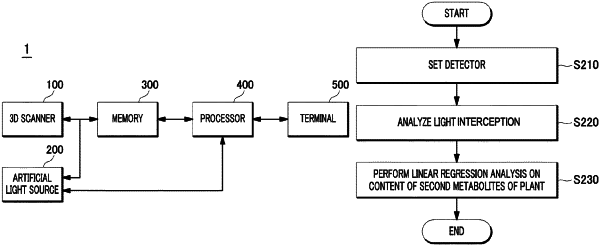| CPC A01G 7/045 (2013.01) [H05B 47/105 (2020.01)] | 6 Claims |

|
1. An artificial light source setting method for controlling secondary metabolites of plant, the artificial light source setting method comprising:
generating a simulation model by using a three-dimensional structure model of the plant and light source data of a plant factory;
predicting content of secondary metabolites of each of a plurality of leaves by analyzing light interception of each of the plurality of leaves included in the three-dimensional structure model of the plant; and
deriving a light source setting value such that the content of secondary metabolites of each of the plurality of leaves has a preset value and changing an artificial light source setting of the plant factory according to the light source setting value,
wherein the generating of the simulation model comprises: generating three-dimensional scan data of the plant by using a three-dimensional scanner; and generating a surface model by using the three-dimensional scan data,
wherein the predicting of the content of secondary metabolites comprises: setting each of the plurality of leaves included in the surface model as a detector; and predicting a light interception amount of each of the plurality of leaves of the plant, and
wherein the predicting of the content of secondary metabolites further comprises: receiving data on optical properties and the content of secondary metabolite of the plant; and performing linear regression analysis on the optical properties and the content of secondary metabolites of the plant.
|